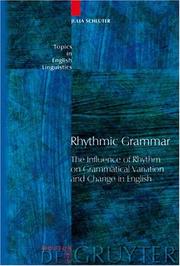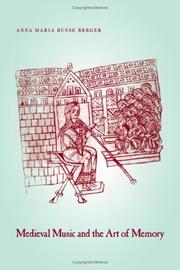| Listing 1 - 10 of 11 | << page >> |
Sort by
|
Book
Abstract | Keywords | Export | Availability | Bookmark
 Loading...
Loading...Choose an application
- Reference Manager
- EndNote
- RefWorks (Direct export to RefWorks)
Individualism --- Rhythm --- Globalization
Book
ISBN: 2745312898 9782745312891 Year: 2005 Volume: 9 Publisher: Paris Champion
Abstract | Keywords | Export | Availability | Bookmark
 Loading...
Loading...Choose an application
- Reference Manager
- EndNote
- RefWorks (Direct export to RefWorks)
82-1 --- Poëzie --- 82-1 Poëzie --- Rhythm --- Poetics --- Rhythm - Congresses --- Poetics - Congresses
Book
ISBN: 9783484351073 3484351071 Year: 2005 Publisher: Tübingen: Niemeyer,
Abstract | Keywords | Export | Availability | Bookmark
 Loading...
Loading...Choose an application
- Reference Manager
- EndNote
- RefWorks (Direct export to RefWorks)
In Klopstocks (1724-1803) mythologischen Eislaufoden wird seine revolutionierende Rolle als Dichter für die literarische Umbruchzeit im 18. Jahrhundert in besonderer Weise greifbar. Zeitgenössische Tendenzen wie Jean Georges Noverres Tanztheorie spiegeln sich in ihnen und ihrer rhythmischen Faktur ebenso wie die Rezeption des altsächsischen »Heliand« oder der antiken rhetorischen Tradition. Dabei wird die Semantik des Rhythmus zum zentralen Moment der Lesbarkeit der Sprache des bewegten Körpers, womit Klopstock das Verhältnis von Körperdynamik und Sprachdynamik für nachfolgende Generationen neu formiert.

ISBN: 0822335026 9780822335023 082233514X 9780822335146 Year: 2005 Publisher: Durham (N.C.) : Duke University Press,
Abstract | Keywords | Export | Availability | Bookmark
 Loading...
Loading...Choose an application
- Reference Manager
- EndNote
- RefWorks (Direct export to RefWorks)
Choreography. --- Dance --- Movement, Aesthetics of. --- Sociological aspects. --- Aesthetics --- Movement, Psychology of --- Rhythm --- Sociology of dance --- Sociology --- Theatrical science --- Choreography --- Movement, Aesthetics of --- Sociological aspects
Book
ISBN: 081220204X Year: 2005 Publisher: Philadelphia : University of Pennsylvania Press,
Abstract | Keywords | Export | Availability | Bookmark
 Loading...
Loading...Choose an application
- Reference Manager
- EndNote
- RefWorks (Direct export to RefWorks)
In 1948, the Orioles, a Baltimore-based vocal group, recorded "It's Too Soon to Know." Combining the sound of Tin Pan Alley with gospel and blues sensibilities, the Orioles saw their first hit reach #13 on the pop charts, thus introducing the nation to vocal rhythm & blues and paving the way for the most successful groups of the 1950s.In the first scholarly treatment of this influential musical genre, Stuart Goosman chronicles the Orioles' story and that of myriad other black vocal groups in the postwar period. A few, like the Orioles, Cardinals, and Swallows from Baltimore and the Clovers from Washington, D.C., established the popularity of vocal rhythm & blues nationally. Dozens of other well-known groups (and hundreds of unknown ones) across the country cut records and performed until about 1960. Record companies initially marketed this music as rhythm & blues; today, group harmony continues to resonate for some as "doo-wop. "Focusing in particular on Baltimore and Washington and drawing significantly from oral histories, Group Harmony details the emergence of vocal rhythm & blues groups from black urban neighborhoods. Group harmony was a source of empowerment for young singers, for it provided them with a means of expression and some aspect of control over their lives where there were limited alternatives. Through group harmony, young black males celebrated and musically confounded, when they could not overcome, complex issues of race, separatism, and assimilation during the postwar period. Group harmony also became a significant resource for the popular music industry. Goosman interviews dozens of performers, deejays, and industry professionals to examine the entrepreneurial promise of midcentury popular music and chronicle the convergence of music, place, and business, including the business of records, radio, promotion, and song writing. Featured in the book's account of the black urban roots of rhythm & blues are the recollections of singers from groups such as the Cardinals, Clovers, Dunbar Four, Four Bars of Rhythm, Five Blue Notes, Hi Fi's, Plants, Swallows, and many others, including Jimmy McPhail, a well-known Washington vocalist; Deborah Chessler, the manager and songwriter for the original Orioles; Jesse Stone, the writer and arranger from Atlantic Records; Washington radio personality Jackson Lowe; and seminal black deejays Al ("Big Boy") Jefferson, Maurice ("Hot Rod") Hulbert, and Tex Gathings.
Rhythm and blues music --- African Americans --- History and criticism. --- Social conditions. --- African Studies. --- African-American Studies. --- American History. --- American Studies. --- Music.

ISBN: 3110186071 9783110186079 9786612296635 1282296639 3110219263 Year: 2005 Publisher: Berlin ; New York : Mouton de Gruyter,
Abstract | Keywords | Export | Availability | Bookmark
 Loading...
Loading...Choose an application
- Reference Manager
- EndNote
- RefWorks (Direct export to RefWorks)
This groundbreaking book highlights a phonological preference, the Principle of Rhythmic Alternation, as a factor in grammatical variation and change in English from the early modern period to the present. Though frequently overlooked in earlier research, the phonetically motivated avoidance of adjacent stresses is shown to exert an influence on a wide variety of phenomena in morphology and syntax. Based on in-depth analyses of extensive electronic databases, the book presents 20 exemplary studies from different structural categories. Among them are much-debated as well as novel issues, including the double comparative worser, 'predicative only' a- adjectives, variant past participles, the placement of the degree modifier quite, the order of conjuncts in binomials, the negation of attributive adjectives and sentence adverbs, variable adverbial marking, the use or omission of the infinitive marker, and the a- prefix before - ing forms. The studies provide qualitative and quantitative evidence of the importance of rhythmic alternation in synchronic variation as well as diachronic change, without neglecting interactions with a set of competing functional tendencies. Thus, the book contributes essential aspects to the description and explanation of the phenomena considered, calling for a fundamental revision of current thinking about the interface between phonology and morphosyntax. In addition, the empirical findings are brought to bear on theoretical discussions of more general interest, yielding a critical assessment of the merits and limitations of two nonmodular linguistic theories: Optimality Theory and spreading activation models. The latter type is developed into a comprehensive conception integrating functional factors such as the Principle of Rhythmic Alternation in an overarching framework for language variation and change. The wide range of subject areas covered makes the volume essential reading and a source of inspiration for linguists with interests as diverse as the phonology-morphosyntax interface, English grammar, the history of English, functional linguistics, Optimality Theory, as well as neuro- and psycholinguistics.
English language --- 802.0-4 --- 802.0-56 --- 802.0-56 Engels: syntaxis; semantiek --- Engels: syntaxis; semantiek --- 802.0-4 Engels: fonetiek; fonologie --- Engels: fonetiek; fonologie --- Grammar, Historical --- Rhythm --- Variation --- Dialects --- Metrics and rhythmics --- Versification --- Phonetics --- Grammar --- Rhythm. --- Grammar, Historical. --- Variation. --- Germanic languages --- English /language. --- Phonology. --- language change.
Book
ISBN: 2130545629 9782130545620 Year: 2005 Publisher: Paris Presses universitaires de France
Abstract | Keywords | Export | Availability | Bookmark
 Loading...
Loading...Choose an application
- Reference Manager
- EndNote
- RefWorks (Direct export to RefWorks)
Sociology --- Rhythm --- Sociologie --- Rythme --- Rhythm Notion --- CDL --- 316 --- Individualism --- Power (Social sciences) --- Globalization --- Global cities --- Globalisation --- Internationalization --- International relations --- Anti-globalization movement --- Empowerment (Social sciences) --- Political power --- Exchange theory (Sociology) --- Political science --- Social sciences --- Consensus (Social sciences) --- Aesthetics --- Movement, Psychology of --- Poetics --- Cycles --- Movement, Aesthetics of --- Economics --- Equality --- Self-interest --- Libertarianism --- Personalism --- Persons
Multi
ISBN: 8822254805 Year: 2005 Publisher: Firenze Leo S. Olschki
Abstract | Keywords | Export | Availability | Bookmark
 Loading...
Loading...Choose an application
- Reference Manager
- EndNote
- RefWorks (Direct export to RefWorks)
Organ music --- 17th century --- History and criticism --- Italy --- History --- Canons, fugues, etc. (Organ) --- Scores --- Musical notation --- Ligatures (Music) --- Music --- Music autography --- Music copying --- Music manuscript --- Music notation --- Musical autography --- Notation, Musical --- Staff notation --- Musical meter and rhythm --- Signs and symbols --- Paleography, Musical
Periodical
ISSN: 18804276 18832148 Year: 2005 Publisher: [Tokyo] : [Tokyo] : [Amsterdam] : Tokyo : Japanese Society of Cardiac Pacing and Electrophysiology, Japanese Heart Rhythm Society Elsevier B.V. Wiley
Abstract | Keywords | Export | Availability | Bookmark
 Loading...
Loading...Choose an application
- Reference Manager
- EndNote
- RefWorks (Direct export to RefWorks)
Arrhythmia --- Arythmie --- Periodicals --- Périodiques --- Cardiac pacing --- Arrhythmias, Cardiac. --- Arrhythmia. --- Cardiac pacing. --- Health Sciences --- Cardiology --- arrhythmia --- cardiac rhythm disorders --- cardiac pacing --- cardiovascular electrophysiology --- cardiology --- Artificial cardiac pacing --- Cardiac pacing, Artificial --- Heart pacing --- Pacing, Cardiac --- Electric stimulation --- Allorhythmia --- Arhythmia --- Arrhythmias --- Cardiac arrhythmia --- Dysrhythmia --- Irregular heart beats --- Heart --- Heart beat --- Electric countershock --- Palpitation --- Arrythmia --- Cardiac Arrhythmia --- Cardiac Arrhythmias --- Cardiac Dysrhythmia --- Arrhythmia, Cardiac --- Dysrhythmia, Cardiac --- Heart Conduction System --- Treatment --- Diseases --- Arrhythmias, Cardiac --- Pathology of the circulatory system --- Arrítmia. --- Arítmia --- Al·lorítmia --- Trastorns del ritme cardíac --- Batecs cardíacs --- Malalties del cor --- Aleteig auricular --- Fibril·lació auricular --- Fibril·lació ventricular --- Taquicàrdia --- Antiarrítmics cardíacs

ISBN: 9786612357312 0520930649 128235731X 1423731344 1598758039 9780520930643 9781423731344 9780520240285 0520240286 9781598758030 Year: 2005 Publisher: Berkeley : University of California Press,
Abstract | Keywords | Export | Availability | Bookmark
 Loading...
Loading...Choose an application
- Reference Manager
- EndNote
- RefWorks (Direct export to RefWorks)
This bold challenge to conventional notions about medieval music disputes the assumption of pure literacy and replaces it with a more complex picture of a world in which literacy and orality interacted. Asking such fundamental questions as how singers managed to memorize such an enormous amount of music and how music composed in the mind rather than in writing affected musical style, Anna Maria Busse Berger explores the impact of the art of memory on the composition and transmission of medieval music. Her fresh, innovative study shows that although writing allowed composers to work out pieces in the mind, it did not make memorization redundant but allowed for new ways to commit material to memory. Since some of the polyphonic music from the twelfth century and later was written down, scholars have long assumed that it was all composed and transmitted in written form. Our understanding of medieval music has been profoundly shaped by German philologists from the beginning of the last century who approached medieval music as if it were no different from music of the nineteenth century. But Medieval Music and the Art of Memory deftly demonstrates that the fact that a piece was written down does not necessarily mean that it was conceived and transmitted in writing. Busse Berger's new model, one that emphasizes the interplay of literate and oral composition and transmission, deepens and enriches current understandings of medieval music and opens the field for fresh interpretations.
Memory. --- Composition (Music) --- Music --- Retention (Psychology) --- Intellect --- Psychology --- Thought and thinking --- Comprehension --- Executive functions (Neuropsychology) --- Mnemonics --- Perseveration (Psychology) --- Reproduction (Psychology) --- Composing (Music) --- Music composing --- Music composition --- Musical composition --- Concertante style --- History. --- History and criticism. --- Composition --- antiphons. --- art. --- carolingian modes. --- chant. --- composers. --- composition. --- discant. --- harmony. --- improvisation. --- intervals. --- intonations. --- isorhythmic motets. --- literacy. --- medieval history. --- medieval music. --- melismas. --- memorization. --- memory. --- music history. --- music theory. --- music. --- musicology. --- nonfiction. --- note progression. --- notre dame polyphony. --- oral composition. --- oral transmission. --- orality. --- organum. --- performing arts. --- polyphonic music. --- polyphony. --- psalm tones. --- pseudo chilston. --- religious music. --- rhythm. --- tonaries. --- transmission. --- visualization.
| Listing 1 - 10 of 11 | << page >> |
Sort by
|

 Search
Search Feedback
Feedback About
About Help
Help News
News